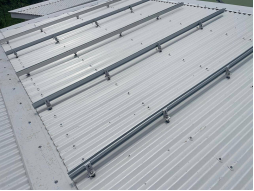Solar rails are one of the vital parts of a photovoltaic (PV) system. They provide structural support which enables solar panels to be securely mounted on the rooftops and even on open lands. With the growing emphasis on shifting to renewable sources of energy, it is very important for consumers and installers, alike, to be aware of the importance of solar rails. This blog is all about the importance of solar rails, their types, installation considerations, as well as trends that are likely to affect this component of solar energy systems in the future.
Understanding Solar Rails
Solar rails are horizontal-supporting grills which ensure that panels are properly mounted and do not fall off. Rails are made of strong materials such as Stainless steel or Aluminum that can be affected by environmental elements (corroded or extreme weather) and provides longevity. The material selected not only determines how long the solar installation lasts, but how efficient it will be as well. A solar rail system is properly installed will boost the performance solar panels by better positioning and minimizing chances of damage.
Kinds of Solar Rails
Every solar installer knows that there are numerous kinds of solar rails, customized to fit particular needs. The most common types are:
Standard Rails: The oldest types used in the majority of installations. These provide basic solar mounting frameworks.
Micro-inverter Rails: These rail are equipped to have micro-inverters. They enable greater flexibility with panel configurations and can improve energy output.
Ballasted Rails: These are used on flat roofs and employs gravity to secure solar panels without puncturing the roof, reducing leaks.
Integrated Systems: Some vendors produce rail constructions where the rail and mount are integrated automatically simplifying the installation.
Installation Considerations
As is the case with all other installations, putting up solar rails has some prerequisites. The most critical one is the type of roof because different materials will demand diverse mounting methods that avoid leaks. Also, the tilt and orientation of the solar panels, responsive to solar irradiance, need to be positioned ideally which is where solar rails can ease the challenge. Also, the relative gaps between the solar panels must be properly set to prevent shading and increase energy output.### The Function of Solar Rails In Energy Efficiency
In the PV system, solar rails offer structural support as well as fulfill the requirements of energy efficiency. As they properly ventilate the panels, solar rails assist in keeping the operating temperature at an optimal level; each of which is important in maximizing the energy output of the system. Also, in places where sunlight is not consistent, the performance of the panels can be significantly improved due to the tilt and orientation adjustments possible with adjustable solar rails.
Expected Advances in Solar Rail Technology
The solar industry grows, solar rails and their respective technologies do as well. Newer designs and materials are creating more streamlined rail systems which increase efficiency and ease of installation. Moreover, the incorporation of solar photovoltaic systems into rail structures is increasing which allows real time changes to be made for maximum energy production to be achieved actively. In addition, manufacturers are looking to friendly materials to construct solar rails due to increasing attentiveness to sustainable business practices aligned with the objectives of the renewable energy sector.
Finally, solar rails adequately perform mechanical and electrical functions within a PV system, affecting the balance of system cost and structural reliability of solar power installations. With further advancement in the industry, consumers and professionals alike will need to follow new trends in rail technology. Understanding the role of solar rails enables informed choices from which all stakeholders will benefit towards the achievement of solar energy goals.




